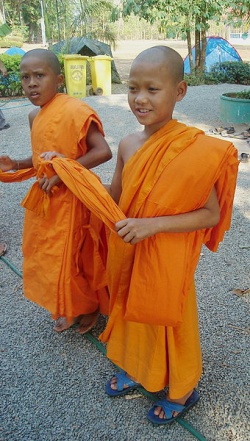Difference between revisions of "Śrāmaṇera"
| Line 20: | Line 20: | ||
{{W}} | {{W}} | ||
| − | + | ||
| − | + | [[Category:Sramanera]] | |
| − | |||
| − | [[Category: | ||
Latest revision as of 01:18, 24 March 2015
A śrāmaṇera (Sanskrit; Pali: sāmaṇera; Burmese: ရှင်သာမဏေ shin thamanei, Thai: สามเณร Samanen, Khmer: សាមណេរ "Samaner") is a novice Monk in a Buddhist context.
The literal meaning is "small śramaṇa," that is, small renunciate, where "small" has the meaning of boy or girl.
In the Vinaya monastic discipline, a man under the age of 20 cannot ordain as a bhikṣu, but can ordain as a śrāmaṇera.
The female counterpart of the śrāmaṇera is the śrāmaṇerī.
Śrāmaṇeras and śrāmaṇerīs keep the ten precepts as their code of behaviour, and are devoted to the Buddhist religious life during a break from secular schooling, or in conjunction with it if devoted to formal ordination.
After a year or at the age of 20, a śrāmaṇera will be considered for the higher bhikṣu or bhikṣuṇī ordination.
Some monasteries will require people who want to ordain as a Monk to be a novice for a set period of time, as a period of preparation and familiarization.
Adults would normally wear the white robes of a Brahmin, as do Mae ji, who do not seek ordination.
Ordination differs between śrāmaṇeras and śrāmaṇerīs.
